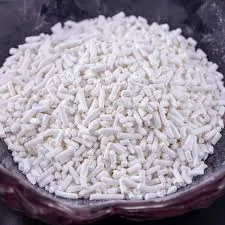
butadiene acrylonitrile
The Importance of Butadiene and Acrylonitrile in Modern Industry
Butadiene and acrylonitrile are two significant chemical compounds that play critical roles in the manufacturing of various materials and products, particularly in the fields of plastics, rubber, and fibers. Understanding their properties, applications, and production processes is essential to appreciate their impact on numerous industries.
Chemical Structure and Properties
Butadiene is a colorless gas at room temperature, with the chemical formula C4H6. It is a conjugated diene, which means it has alternating double bonds, which endows it with unique reactivity characteristics. These characteristics make butadiene a vital building block in the production of synthetic rubber, particularly in the production of polybutadiene rubber (BR) and styrene-butadiene rubber (SBR). The latter is widely used in automobile tires, shoes, and various elastomer applications due to its excellent resilience and durability.
Acrylonitrile, on the other hand, is a colorless liquid with a slightly pleasant odor, and it has the chemical formula C3H3N. It is a crucial monomer for the production of polyacrylonitrile (PAN) and various copolymers, including acrylonitrile-butadiene-styrene (ABS), which is renowned for its strength and impact resistance. Acrylonitrile's polar nature enhances its affinity with other polar materials, making it a desirable component in various applications across multiple industries.
Production Processes
The production of butadiene typically involves the steam cracking of hydrocarbons derived from natural gas or crude oil. During this process, ethylene, propylene, and butadiene are produced simultaneously. The separation and purification of butadiene from these by-products are crucial for its subsequent industrial applications.
Acrylonitrile is produced primarily through the sequential hydration of propylene oxide, which is derived from petroleum or natural gas. The process incorporates steps that involve the reaction of propylene with ammonia and water, followed by oxidation. This sequence generates acrylonitrile as a product, which is then purified and polymerized for various uses.
Applications
butadiene acrylonitrile

The applications of butadiene are vast. It is mainly used to manufacture synthetic rubber, which accounts for a significant portion of the global rubber market. Butadiene-derived synthetic rubber offers superior performance characteristics, including improved wear resistance and elasticity, compared to natural rubber.
In addition to its role in rubber production, butadiene is essential in the synthesis of various plastics and other chemical intermediates. It serves as a precursor for producing polybutadiene, which is widely utilized in automotive components and consumer goods.
Acrylonitrile is equally important, with a primary application in the textile industry. Polyacrylonitrile fibers are known for their lightweight, strength, and UV resistance, making them popular in outdoor apparel and insulation materials. Moreover, ABS, a copolymer of acrylonitrile, butadiene, and styrene, is widely used in the manufacturing of consumer products such as toys, appliances, and automotive parts due to its excellent impact resistance and thermal stability.
Environmental and Safety Considerations
Despite their industrial significance, both butadiene and acrylonitrile pose environmental and health risks. Butadiene is classified as a possible human carcinogen, with inhalation exposure leading to respiratory and neurological effects. Proper safety measures and regulations are crucial to mitigate these risks during manufacturing and use.
Acrylonitrile also carries health hazards, including toxicity and flammability. It is essential to handle acrylonitrile in controlled environments with adequate protective measures to safeguard workers and minimize environmental impact.
Conclusion
In conclusion, butadiene and acrylonitrile are fundamental chemicals that significantly impact modern manufacturing and industry. Their diverse applications in rubber, plastics, and textiles underscore their importance in everyday life. However, it is vital to consider the environmental and health implications associated with their production and use. As industries continue to innovate and evolve, the responsible use of these chemicals will be critical to balancing industrial growth and environmental stewardship.
-
Understanding Synthetic Rubber OptionsNewsApr.27,2025
-
Trichloroisocyanuric Acid: Essential for Clean and Safe WaterNewsApr.27,2025
-
Sodium Dichloroisocyanurate: Key to Safe Water TreatmentNewsApr.27,2025
-
Sodium Acid Pyrophosphate: Essential in Modern Food ProcessingNewsApr.27,2025
-
Essential Water Treatment ChemicalsNewsApr.27,2025
-
Denatured Alcohol and Its Industrial UsesNewsApr.27,2025
-
The Versatile Uses of Sodium BicarbonateNewsApr.24,2025
Hebei Tenger Chemical Technology Co., Ltd. focuses on the chemical industry and is committed to the export service of chemical raw materials.
-

view more DiethanolisopropanolamineIn the ever-growing field of chemical solutions, diethanolisopropanolamine (DEIPA) stands out as a versatile and important compound. Due to its unique chemical structure and properties, DEIPA is of interest to various industries including construction, personal care, and agriculture. -

view more TriisopropanolamineTriisopropanolamine (TIPA) alkanol amine substance, is a kind of alcohol amine compound with amino and alcohol hydroxyl, and because of its molecules contains both amino and hydroxyl. -

view more Tetramethyl Thiuram DisulfideTetramethyl thiuram disulfide, also known as TMTD, is a white to light-yellow powder with a distinct sulfur-like odor. It is soluble in organic solvents such as benzene, acetone, and ethyl acetate, making it highly versatile for use in different formulations. TMTD is known for its excellent vulcanization acceleration properties, which makes it a key ingredient in the production of rubber products. Additionally, it acts as an effective fungicide and bactericide, making it valuable in agricultural applications. Its high purity and stability ensure consistent performance, making it a preferred choice for manufacturers across various industries.











